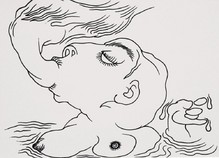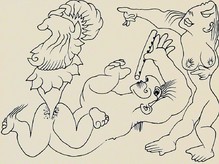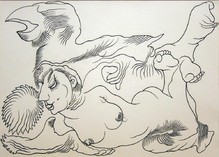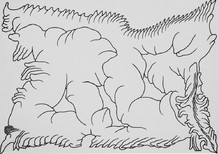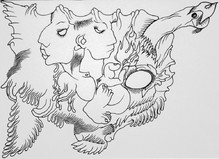
M. Natesh
Chennai, India Born 1960
-
From 02 May-2007 To 03 Jun-2007
-
From 16 Oct-2015 To 08 Nov-2015
-
From 16 Feb-2017 To 19 Feb-2017
-
From 01 Apr-2020 To 30 Apr-2020
-
From 01 Sep-2020 To 07 Sep-2020
-
From 11 Jan-2022 To 18 Jan-2022
-
From 01 Jun-2022 To 30 Jun-2022
-
From 14 Jul-2023 To 23 Jul-2023
Postgraduate diploma in Fine Arts, specialising in painting, from the Government College of Arts & Crafts, Madras (1980-1986); Studied silk-screen printmaking under British group of poster designers (1982)
†
Selected Solo Exhibitions
Drawings Exhibition, The Madras Terrace House, Chennai (2010); Solo Exhibition of Drawings & 'The Bird', Installation, Alliance Francaise, Chennai(2004); Current Paintings and mural execution, Alliance Francaise, Chennai (2002); Paintings Exhibition, Alliance Francaise, Chennai (1999); Alliance Francaise, Chennai (1997)
†
Selected Group Exhibitions
Art Chennai 2011, The Faraway Tree Gallery, Chennai (2011); Drawn from India: The Work of S. Ravi Shankar and M. Natesh, The Noble Sage, London (2007); Installation at National Camp for Installation Art, Lucknow (2005); 'Meglomaniac' & 'Shiva', Installations, Alliance Francaise amphitheatre, Chennai (2003); 'Water', Installation, Max Muller Bhavan, Chennai (2002); The limits of Transgression' Installation, Max Muller Bhavan, Chennai (2001); 'Nungamba', Two installations, Alliance Francaise amphitheatre, Chennai (2001); Chennai Collaborative Installation titled 'Mudhras: Meaning and Metaphor' with artist Ernst Hesse, Max Muller Bhavan, Chennai (2000); 'Collaboration' - multimedia group show, The Gallery, Chennai (2000); Three-person Exhibition at Jehangir Art Gallery, Mumbai (1999); Performance Installation & Exhibition of work executed in Dusseldorf, Max Muller Bhavan, Chennai (1999); 'Sky is the Limit' installation, Max Muller Bhavan, Chennai (1998); Installation, Alliance Francaise, Chennai(1998); Installation and Exhibition of Paintings, Alliance Francaise, Pondicherry (1998); Installation for Pandit Ravi Shankar's 'Ganashyam' (1990); Kamal Nayan Gallery, Bombay (1988); Chitra Kala Parishad, Bangalore (1986); Two-man Paintings Exhibition at Lalit Kala Academy Chennai (1985)
Natesh refers to himself as a proper Madrasi - born and bred in Chennai. His love of art can be rooted back to the age of three when he would scribble all over the floor of his house with a piece of chalk. Though at first focused on a career in science, particularly astrophysics (at the age of sixteen the artist built his own telescope), Natesh soon returned to his natural talent. In his first drawing classes he came under the guidance of famous South Indian artist, Professor R.B. Bhaskaran, his Zen master as Natesh puts it. Natesh remembers how Bhaskaran liberated him, showing how to release the pencil and get some freedom out of the line. The next day instead of four drawings, he made thirty-four. It was a turning point for the young artist.
†
After experiencing the impact of the European Masters at the Madras College of Arts & Craft, the young Natesh was soon drawn to Indian temple art -especially Chola and Pallava art. Following the lines of these works of art began a realisation that looking to Europe was unnecessary modernity was alive in India. Those ancient works of art had a style like no other and it was wrong to see them as primitive, decorative works of the past. To Natesh they were highly conceptual, each line having a psycho-spiritual embodiment. This indeed was the Indian way. On completing his studies at the Government College in 1986, Natesh moved forward simultaneously as a gifted artist as well as a talented theatre set designer. His father, a well-known Tamil playwright, aided him in this second course and this happy cross-fertilisation continues even today. Natesh doesnt see the two arenas as at odds with each other. In both, he is creative to instil in the audience a message significant to him. With this theatricality of message in mind, it is unsurprising that Natesh, since 1999, has become a key propagator of installation art. Still a relatively new field to the Chennai art scene, Natesh has caused quite a stir with his installation pieces. In Bhishma Unborn (2000), for example, Natesh summons up a menacing anti-war message. A large egg-shaped cage, a real egg within it, is laid on a bed of nails (referencing Bhishma in the Mahabharata and his bed of arrows i.e. a violent world). The meaning is plain: killed the moment it is born. Nateshs installations have a strength not often seen in other Chennai installation artists. He has come to be nicknamed by the press as the angry artist, Natesh. You can see why.
†
Natesh is one of the few southern artists to include his paintings in his installations. They often are fastened to bamboo sticks or displayed close-by on an adjoining wall, stretched out like a colourful political banner. They have a similar effect to laying a rose on a tank: heavily meaningful, adding colour to a stark reality. His paintings, seen singularly, are very different to his installations, and hold little in common with his drawings. They are brash, colourful renderings of animals, dream-like gaudy landscapes and bright underwater scenes.
†
Although he describes his home as his cemetery due to the debris left from installations and theatre sets, there is a quiet space left uncluttered for him to concentrate on his drawing. Every morning Natesh sits down to produce fluid line drawings that are amazing to behold. In recent years, he would begin by drawing one of his Ganeshes. He sees Ganesh as the ultimate warm-up: capturing Ganeshs voluptuous body and cheery disposition. Many of his contemporaries describe him as a classicist because of his drawings. He puts this down to the design element conspicuous in his finished pieces. In his words, he looks for fluidity through symmetry and repetition of line and form. The resultant drawings are comparable with that of Michelangelo and Da Vinci due to their attention to the equal division of compositional space. There is a rhythm of line and a symmetry in the asymmetry that resonates the classical.
†
Often it is the starting point of a line insinuating an outline of a body part that begins an entire drawing: a hand is real and from that hand a finger emerges that finger becomes abstract, a concept, a design concept that becomes simplified and repeated over and over again I travel from one thing to another there is no break sometimes. He never starts in the same place, moving with ease from one corner of the page to the adjacent edge and back again. His experiences and ideas fall onto the page unconsciously: a recent bereavement, a play he had seen, a dream the previous night, a political belief, an environmental concern or an inspiring artwork. The final imagery is a surreal connection of toes, tendrils, tentacles, thumbs, knuckles, elbows, wings and open palms. These are morphed together picto-genetically: hands become beaks, wings become feet, and knee joints become elbows. To Natesh, it is a reference to the world around us and its strange future metamorphosis into something ugly and bizarre. The environment and the existence, treatment and depletion of animals are key themes. It is the angry artist that comes through here, a favourite topic being mans consumption of the planet. In his drawings, mankind is often pictured as a gluttonous ogre. One might say that the artist punishes man through his drawings giving him an expanded anus, a gorged mouth or flaccid limbs. Nateshs drawings are certainly strange and exciting for the viewer: grotesque and elegant in equal measure, comical and tragic in the same lyrical line.






